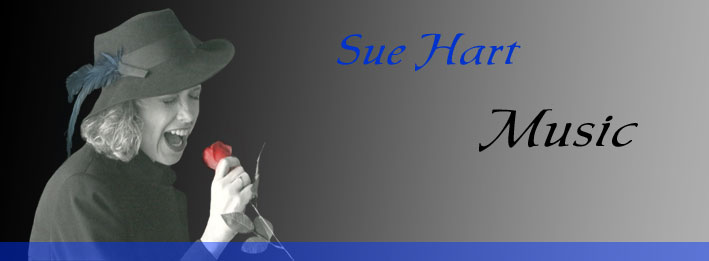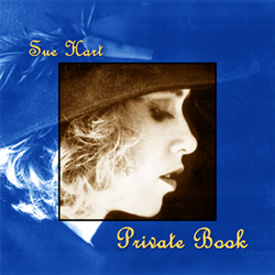
![]()
Jazz Singer,
Sue Hart, has
released her new cd, Private Book,
on SatTat Records, a masterful blend of smooth jazz, bossa
nova, and jazz pop songs with an easy listening sound. Hear
song samples below.
|
$10.00
+ $2.00 shipping (Tax Included) |
 |
|
|
|
Sue Hart:
Vocals Produced
by James Shattuck |

![]()
|
Cool West Coast Jazz Cool
Jazz evolved directly from bop in the late '40s and '50s. Essentially,
it was a mixture of bop with certain aspects of swing that had been
overlooked or temporarily discarded. Dissonances were smoothed out,
tones were softened, arrangements became important again, and the
rhythm section's accents were less jarring. Because some of the
key pacesetters of the style (many of whom were studio musicians)
were centered in Los Angeles, it was nicknamed "West Coast
jazz." Some of the recordings were experimental in nature (hinting
at classical music) and some overarranged sessions were bland, but
in general this was a viable and popular style. By the late '50s,
hard bop from the East Coast had succeeded cool jazz, although many
of the style's top players had long and productive careers. Among
the many top artists who were important in the development of cool
jazz were Lester Young, Miles Davis, Gerry Mulligan, Stan Getz,
Shorty Rogers, and Howard Rumsey (leader of the Lighthouse All-Stars). Bossa Nova - In The Beginning Influenced by West coast jazz, in the 1950s composer Antonio Carlos Jobim helped to form Bossa Nova, a new music that blended together gentle Brazilian rhythms and melodies with cool-toned improvising; the rhythms are usually played lightly as 3-3-4-3-3 with beats 1, 4, 7, 11, and 14 being accented during every two-bars (played in 8/4 time). Joao Gilberto's soothing voice perfectly communicated the beauty of Jobim's music. The late '50s film Black Orpheus helped introduce Jobim's compositions to an American audience. Other important early exponents of bossa nova were guitarist Charlie Byrd, tenor saxophonist Stan Getz (Byrd and Getz teamed up for the highly influential Jazz/Samba), and housewife-turned-singer Astrud Gilberto — who, along with her husband (Joao) and Getz, made "The Girl From Ipanema" a huge hit. The very appealing bossa nova's popularity peaked in the mid-'60s, but it has remained a viable music style. — Scott Yanow Jazz - Pop Ever since jazz singer / artist Louis Armstrong introduced virtuoso-quality improvisation to the world of jazz music, there has been dissent in the jazz community about whether the music should emphasize melodic accessibility, and the artistic merits of music that does so wholeheartedly. Jazz music has a well-established custom of using pop standards as jumping-off points for lengthy improvisations, satisfying jazz lovers and purists who appreciate the unpredictability and constant chance-taking. However, ever since the big-band era, there has also been a long-standing tradition of Jazz-Pop — music that retains the melodic and rhythmically swinging qualities of jazz music (as well as the basic chordal harmonies), but which (like pop) concentrates first and foremost on memorable melodies, usually with little to no improvisation. In jazz's early days, dance orchestras began to adopt swing rhythms to keep in step with audience tastes. As the big band era wore on, most groups fell into one of two categories: sweet bands, which retained at least a lightly swinging feel but prized melody above all else, and hot bands, which were distinguished by greater solo improvisation, rhythmic drive, and blues feeling. Sweet bands helped pave the way for the rise of pop singers like Frank Sinatra, Tony Bennett, and Mel Tormé, who were at the very least strongly influenced by jazz music. But really, when most listeners think of jazz-pop, they think of it in the post-rock & roll era. During the '60s, two dominant strains of jazz-pop developed. The first was a mellow, smooth jazz, almost easy-listening strain of jazzy pop epitomized by artists like the Dixieland-influenced Al Hirt and the Latin-tinged Herb Alpert. The other sprang up as a sort of middle ground between the grooving, funky soul-jazz that became popular during the decade, and instrumental soul artists like Junior Walker and the Stax/Volt combos (Booker T. & the MG's, the Mar-Keys, the Bar-Kays). In this vein, the Ramsey Lewis Trio scored a pop smash in 1965 with their catchy "The In Crowd," and the trio's rhythm section — reconstituted as Young-Holt Unlimited — repeated the feat in 1969 with "Soulful Strut." History of Jazz Music Continued |